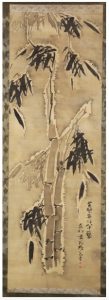
Obaku Taiho (Japanese, 1691–1774), Bamboo in Snow, 1771, Ink on silk, 44 ⅝ x 14 ⅞ inches, Gift of an anonymous donor, 80.184
Bamboo is considered by many New Orleans area gardeners to be an invasive pest. In Japan and in other parts of East Asia, however, bamboo has much more positive associations, and is one of the most commonly encountered subjects in the arts. Symbolizing spring, regeneration, and long life, this persistent perennial also serves as a visual metaphor for the upright individual: someone who is strong, flexible, and with the capacity to withstand great adversity.
The creator of this work, the Buddhist monk, Obaku Taiho (1691–1774) emigrated to Japan from China in 1722, founding a temple outside of Kyoto. In addition to his spiritual role, Taiho was a highly influential painter and calligrapher. Here, using varying tones of black ink, he paints his favorite subject, aglow in the moonlight. The snow that covers the leaves is indicated by the surrounding gray wash.
Evoking quiet fortitude, this ink painting is both a meditation upon and an affirmation of the best characteristics of humanity. Taiho asserts that the will to survive will not be stilled by darkness, cold, or snow. The future is, of course, unknown. However when conditions permit, we, like the bamboo, will re-emerge—bent perhaps, but not broken.
—Lisa Rotondo-McCord, Deputy Director for Curatorial Affairs/Curator of Asian Art
NOMA is committed to uniting, inspiring, and engaging diverse communities and cultures through the arts — now more than ever. You can support NOMA’s staff during these uncertain times as they work hard to produce virtual content to keep our community connected, care for our permanent collection during the museum’s closure, and prepare to reopen our doors.
▶ DONATE NOW
